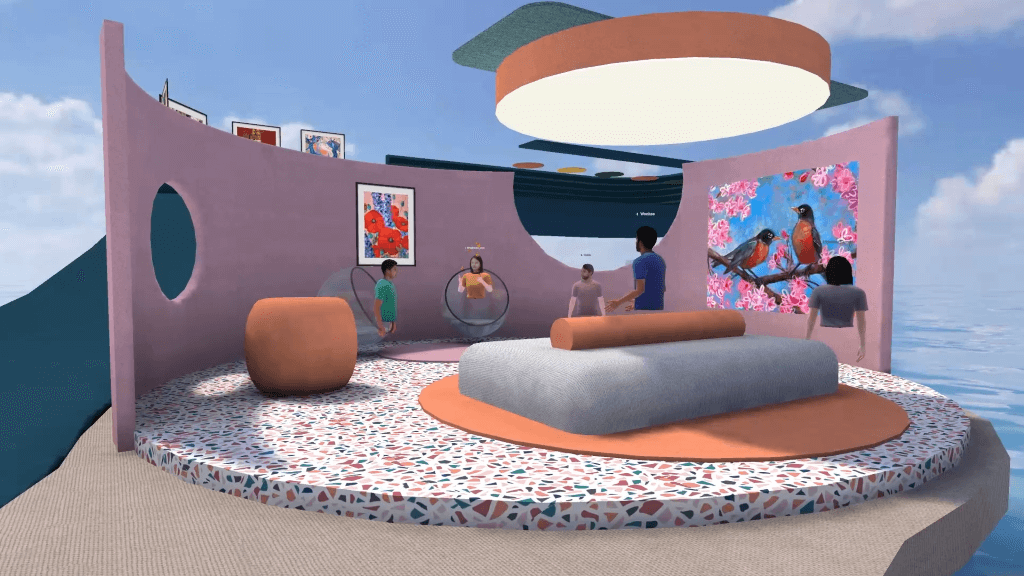If you use VR for professional remote collaboration and/or you’re a regular reader of ARPost, you probably know about Spatial. The platform has an AR and a VR component available in desktop or immersive modes and is widely known for breaking ground on photorealistic avatars (for better or worse).
Spatial is still around, but they’ve changed lanes a little.
Meet the New Spatial
The last time that we checked in on Spatial, it was for our hands-on review of the platform earlier this year. The platform also made our list of AR remote work platforms from a few months earlier.
So, what’s new? The company has recently announced a move “to become the metaverse for cultural events such as NFT exhibitions, brand experiences and conferences.” The change was announced along with a $25M funding round. Spatial had been pivoting already, due to the comparative success of its 2D offering.
To be clear, “comparative success” of a 2D offering doesn’t mean that there was anything wrong with the immersive version. In many ways it was ahead of its time, offering something similar to more recent experiences like Microsoft’s Mesh and Varjo’s Reality Cloud. Still, many companies that do offer immersive experiences find greater adoption of a 2D format.
A great example of this is Virbela. Some people have virtual offices in Virbela that they work in full-time, which would be a tall order if it required users to be in a headset. Still, Virbela does offer their 2D browser-based FRAME. So, why didn’t Spatial “go the course” or create a companion product?
The team at Spatial didn’t just notice how users were accessing the product, they noticed what users were accessing the product to do.
Why This? Why Now?
“Over the last year since we launched our freemium version across any platform, we’ve witnessed a fascinating shift occurring,” Jacob Loewenstein, Head of Business at Spatial said in a release shared with ARPost. “We’ve gone from an AR/VR platform focused on enterprise productivity to a web/VR platform linking digital creators and the broader NFT economy.”

“NFT” is short for “Non-Fungible Token.” It’s a piece of blockchain data associated with a digital artifact that can be used to prove ownership of that digital artifact. Ownership of digital items has long been a problem for digital artists and NFTs are allowing them to market, sell, and control their work in ways that weren’t previously possible.
Further, because NFTs are enabled on a blockchain (usually Ethereum), and many different platforms can use the same blockchain, NFT digital assets can often exist across multiple different platforms in ways that other digital assets can’t. This lends interoperability to these compatible platforms – something that the metaverse greatly needs and hasn’t yet managed.
“We’re witnessing this trend in the creator economy from the inside and can see the huge opportunity as power moves into the hands of these creators,” said Loewenstein. “We believe in an inclusive and open metaverse where one day artists and creators can move freely across multiple virtual platforms with interoperable portals, avatars and shared spaces.”
An Act of Convergence
There’s something else as well. Because NFTs arose out of the blockchain space rather than the immersive technology space, there are theories about NFTs in the metaverse but there are few actual overlaps of these technologies to date. So, while there is immersive tech interest in NFTs, there aren’t a lot of ways to view NFTs in immersive environments.
That is compared to the remote collaboration market which isn’t necessarily “saturated” – but there’s certainly a lot more competition there. A lot of people in the immersive tech space have been waiting for NFTs to arrive and Spatial is bringing immersive tech to the NFT community.

“It’s extremely rewarding to devote our energy to empowering creative individuals and lead this cultural paradigm shift in how people are sharing experiences with others,” Jinha Lee, Spatial co-founder and CPO, said in the release.
The company is minting some of its own immersive environments but is also partnering with artists as well as established organizations in the conventional art space, like the Hermitage Museum, as well as in the NFT space, like OpenSea.
Ah Yes, My Spatial Home
This pivot isn’t just them minting some environments and pitching to a new audience. The company’s website has been improved, new environments and host/interaction tools have been added, and the MetaMask Ethereum wallet has been integrated. Users also now have access to a “Spatial Home” where they can hang their crypto collectibles.
It’s a whole new Spatial for a whole new world.




